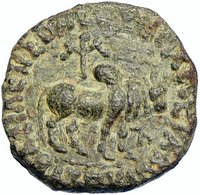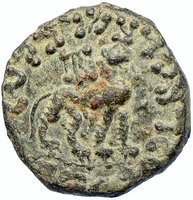Indo-Skythian Kings and Satraps in India
Azes I - King circa 58-12 B.C.
Bronze 23mm (13.63 grams) Pushkalavati mint
Reference: HGC 12, 657; ISCH 2, 102; M. 850; BMC 151
ΒΑΣΙΛΕΩΣ BΑΣΙΛΕΩΝ MEΓΑΛΟΥ AZOY, Bull standing right; monogram above and Kharoshthiletter to right.
Lion standing right; monogram above; Karosthi legend, (Maharajasa rajarajasa mahatasa Ayasa [of Great King, King of Kings Azes the Great]). You are bidding on the exact item pictured, provided with a Certificate of Authenticity and Lifetime Guarantee of Authenticity.
Azes I (Greek: Ἄζης; c. 58/57 BCE - c. 35 BCE) was an Indo-Scythian ruler who completed the domination of the Scythians in northern India.Although Maues and his successors had conquered the areas of Gandhara, as well as the area of Mathura from 85 BCE, they were unsuccessful against the Indo-Greek kings remaining behind the Jhelum River in eastern Punjab. Azes's most lasting legacy was the foundation of the Azes era. It was widely believed that the era was begun by Azes's successors by simply continuing the counting of his regnal years. However, Prof. Harry Falk has recently presented an inscription at several conferences which dates to Azes's reign, and suggests that the era may have been begun by Azes himself. Most popular historians date the start of the Azes era to 58 BC and believe it is the same as the later era known as the Malwa or Vikrama era. However, a recently discovered inscription dated in both the Azes and the Greek era suggests that actually this is not the case. The inscription gives the relationship Azes=Greek + 128. It is believed that the Greek era may have begun in 173 BCE, exactly 300 years before the first year of the Era of Kanishka. If that is the case then the Azes era would begin in about 45 BC.[2] According to Senior, Azes I may have been identical with Azes II, due to the discovery of an overstrike of the former over the latter.

Asia in AD 1, showing the Indo-Scythians and their neighbors.Indo-Scythians is a term used to refer to Scythians (Sakas), who migrated into parts of central and northern South Asia (Sogdiana, Bactria, Arachosia, Gandhara, Sindh, Kashmir, Punjab, Haryana, Rajasthan, UP and Bihar.), from the middle of the 2nd century BC to the 4th century AD. The first Saka king in south Asia was Maues (Moga) (1st century BC) who established Saka power in Gandhara (modern day Pakistan and Afghanistan region) and gradually extended supremacy over north-western India. Indo-Scythian rule in northwestern India ended with the last Western Satrap Rudrasimha III in AD 395 who was defeated by the Indian Emperor Chandragupta II of the Gupta Empire. The power of the Saka rulers started to decline in the 2nd century AD after the Indo-Scythians were defeated by the south Indian Emperor Gautamiputra Satakarni of the Satavahana dynasty . Later the Saka kingdom was completely destroyed by Chandragupta II of the Gupta Empire in the 4th century. The invasion of India by Scythian tribes from Central Asia, often referred to as the Indo-Scythian invasion, played a significant part in the history of South Asia as well as nearby countries. In fact, the Indo-Scythian war is just one chapter in the events triggered by the nomadic flight of Central Asians from conflict with tribes such as the Xiongnu in the 2nd century AD, which had lasting effects on Bactria, Kabul, Parthia and India as well as far-off Rome in the west. Some agrarian and artisan communities (e.g. Rajputs, Jats, Lohars, Tarkhans, Bunts, Nairs etc.) in western India are derived from the Scythians, who settled north-western and western South Asia in successive waves between 500 B.C. to 500 AD.[citation needed] It has been claimed that ancient Roman historians including Arrian[citation needed] and Claudius Ptolemy have mentioned that the ancient Sakas ('Sakai') were basically nomads. However, Italo Ronca, in his detailed study of Ptolemy's chapter vi, marks the statement: "The land of the Sakai belongs to nomads, they have no towns but dwell in forests and caves" as spurious.
Azes II (reigned circa 35-12 B.C. / 5 A.D.), may have been the last Indo-Scythian king in northern India. After the death of Azes II, the rule of the Indo-Scythians in northwestern India finally crumbled with the conquest of the Kushans, one of the five tribes of the Yuezhi who had lived in Bactria for more than a century, and who were then expanding into India to create a Kushan Empire. Soon after, the Parthians invaded from the west. Their leader Gondophares temporarily displaced the Kushans and founded the Indo-Parthian Kingdom that was to last until the middle of the 1st century CE. The Kushans ultimately regained northwestern India circa 75 CE, where they were to prosper for several centuries. The Bimaran casketAzes II is also connected to the Bimaran casket, one of the earliest representations of the Buddha. The casket, probably Greek work, was used for the dedication of a stupa in Bamiran, near Jalalabad in Afghanistan, and placed inside the stupa with several coins of Azes II. This event may have happened during the reign of Azes (35-12 BCE), or slightly later. The Indo-Scythians are otherwise connected with Buddhism (see Mathura lion capital), and it is indeed possible they would have commendited the work. CoinageCoins attributed to Azes II's use Greek and Kharoshti inscriptions, depict a Greek goddess as his protector, and thereby essential follow the numismatic model of the Greek kings if the Indo-Greek kingdom, suggesting a high willingness to accommodate Greek culture. An originality of the Indo-Scythians is to show the king on a horse, rather than his bust in profile as did the Greeks. Other coins of Azes depict the Buddhist lion and the Brahmanic cow of Shiva, suggesting religious tolerance towards his subjects. In the coin depicted to the left Azes is depicted with the inscriptions: Azes II was long believed to have issued several of the Indo-Scythian coins struck under the name Azes in northern India. All these coins were however likely issued by a single ruler named Azes, as suggested by Robert Senior, when he found an overstrike of a coin attributed to Azes I over a coin attributed to Azes II, suggesting that all the "Azes II" coins were not later than those of "Azes I" and that there was only one king in the dynasty named Azes.. This idea had long been advocated by Senior with a number of indirect numismatic arguments, for instance in his encyclopaedia of Indo-Scythian coins .
|




